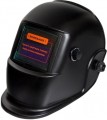Filter class
Class is a complex indicator that determines the overall quality of the light filter in a chameleon mask (see "Type"). The class is indicated by 4 numbers, each of which describes a specific optical parameter. So, the first number indicates the overall clarity and lack of distortion; the second is the degree of light scattering; third — uniformity of blackout (presence/absence of visible blackout spots); the fourth is the angular dependence (how much the filter brightens when the angle of view deviates from the perpendicular). In each case, the larger the number, the worse this parameter is. The perfect indicator is considered to be 1/1/1/1, but in fact it is very difficult to achieve an perfect angular dependence, and there is no need to. Therefore, an indicator of 1/1/1/2 is considered quite sufficient even for a high-end professional filter.
Darkening adjustment
The ability to manually select the degree of darkening of the filter in the chameleon mask. This feature is found mainly in professional models; it allows the welder to manually adjust the light transmission for specific conditions. The need
to adjust the dimming is due to the fact that for some types of work (for example, TIG welding of ferrous metals), the brightness of the arc is relatively low, and in order to see the weld pool normally, dimming of only 8-9 DIN is enough instead of the usual 12 DIN or more .
Delay time adjustment
The ability to manually set the delay time between the disappearance of the arc and turning off the filter in the chameleon mask. Such a delay is highly desirable in the light of the fact that even after the arc is turned off, the heated metal continues to glow for some time; therefore, it is advisable not to turn off the filter immediately.
Adjusting the delay time allows the welder to independently choose the time to return to the non-working (maximally transparent) state.
Design features
— Backlight. Illumination system built right into the mask. This feature is very convenient when working in low light conditions: the backlight does not take up the hands (unlike hand-held flashlights) and does not create problems with wearing a mask (unlike headlamps), while the beam of light is always directed to where the welder's head is turned. On the other hand, such a system requires its own power supply. Therefore, it is used only in "chameleons", while the operation of the backlight additionally consumes battery power.

